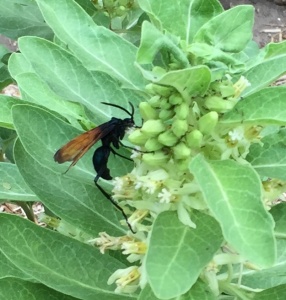Greg Storms was the first to point out the giant wasp while we prepped an area prior to planting our cache of zizotes, Asclepias oenotheroides, the milkweed at the new Zizotes Circle garden in Harlingen’s Hugh Ramsey Nature Park.
“Tarantula wasp,” he said. We didn’t doubt him for a second — the thing was as big as a small tarantula! It seems to have designated itself our mascot as it’s been with us throughout our zizotes project.
Fortunately it minds its own business and seems to appreciate the zizotes as much as we do.
Since it is always on the milkweed, I got to wondering, do wasps consume nectar? I Googled “tarantula wasp” and came up with Tarantula Hawk. The photos on the web were identical to what we had been seeing.
Wasps are important pollinators, in the same order as bees and ants, according to one website. Because of their large stingers, the tarantula hawk has very few predators, although the roadrunner is one.
According to Wikipedia, Tarantula hawk is nectivorous. They feed off the flowers of milkweed, western soapberry trees and mesquite trees. Not aphids, unfortunately.
Another website, http://www.desertusa.com/insects/tarantula-hawks.html, writes that they have been known to become “flight-challenged” after consuming fermented fruit.
The tarantula hawk is not aggressive, unless you are a tarantula.
One big caution, according to all the information I read during my quick research is that although not lethal, they do have a mighty powerful sting. I’ll share one more website with you because it’s such an amusing read about the wasp’s sting that’s well worth a read. It also details the breeding habits of the tarantula hawk for those who are interested: http://www.wired.com/2015/07/absurd-creature-of-the-week-tarantula-hawk/

I remember this day very well. Thanks for documenting on our Web Page.